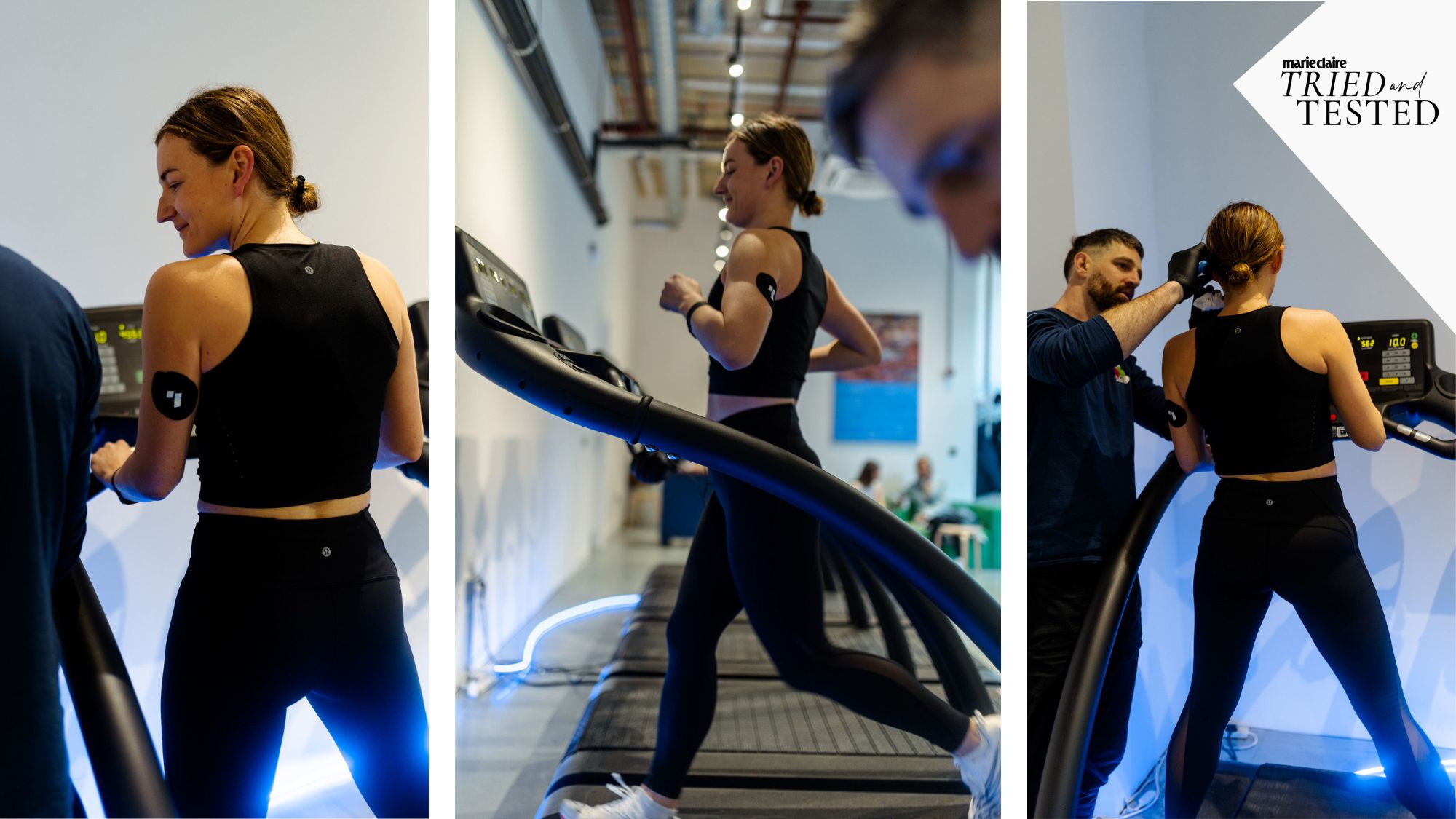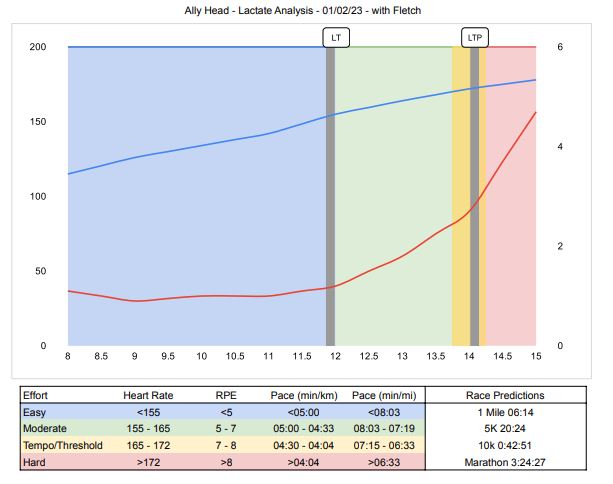This test taught me how to workout smarter, not harder - how it could improve your fitness, too
I beat my half marathon PB shortly after the test as a result.

Spoiler alert: I really like running. I've run eight marathons in my time and have Berlin Marathon in the calendar for September - it's my form of escapism, my way of unwinding after a busy day, and my happy place.
I'm very lucky, as a Health Editor, that I'm constantly updated with the latest innovations, tips and tricks for boosting my training and levelling up my fitness, from strength training for running, which has injury proofed my body for the last three years, to acupuncture for muscle release.
That said, after a gruelling marathon training cycle for Chicago Marathon last year, I was tired and looking for alternative ways to improve my fitness (I learnt the hard way that often, less is more).
That's why, when biomechanics coach, trainer, and co-founder of OneTrack Anthony Fletcher reached out to me with a fitness test that promised to help me workout smarter, not harder, I was intrigued. Was this just another fad or fitness gimmick?
Short answer: no. He introduced me to lactate threshold testing - a measure of the concentration of lactate in your blood - which not only estimated some pretty accurate personal bests for me but has also hugely benefited my training, since.
So, how could this benefit you? Good question. In short, if you're someone who finds it hard to fit exercise in, a lactate test can inform your training more efficiently and lead to improved fitness from shorter workouts - yes, really. "I find a lot of people feel they have to try to get in hour long workouts five times a week, but actually, working smarter for shorter can be better," explains Fletch.
Intrigued? I thought you might be. Keep scrolling to see how I get on and learn more about how the test could boost your fitness, too. Don't miss our guides to running for beginners, training tips for a marathon, and how to run faster, while you're here.
Marie Claire Newsletter
Celebrity news, beauty, fashion advice, and fascinating features, delivered straight to your inbox!
I tried a lactate threshold test - and it helped me get in my best shape ever
What is a lactate threshold test?
Normally used by top coaches and athletes, a lactate test measures the point at which your body's lactate levels start to rise. The term "lactate threshold" simply refers to the point at which lactate starts to accumulate in the blood (aka, the point that it rises above resting levels).
"We simply take a sample of blood (a very small pin prick from the ear) and then analyse it for the concentration of lactate present at that time," shares Fletch.
This can be helpful for a whole number of reasons, shares Fletch, but largely because it shows you your personal best pace. "Say you're marathon training," he shares. "This test may help you to better plan your runs by knowing what speeds you should be aiming for during interval training."
More generally, it’s simply a measure of your aerobic system and its ability to work at certain intensities. "What this test really looks for is the point at which you pass your lactate threshold - aka, when lactate levels start rising above resting level and your body starts to switch to the more dominant fuel source," he explains. If you know this point, you know your personal best pace, or the fastest pace you can run without blowing up.
Did you know? Even at rest, we are producing lactate (0.8 - 1.2mmol·L-1) - "a mandatory by-product of using glucose as fuel," shares the trainer.
In my case, my lactate levels were tested while I was running and then cross-referenced with my pace.
A post shared by Onetrack Run Club (@onetrack_club)
A photo posted by on
Why could it be beneficial for your fitness?
It might sound a bit, well, designed for athletes, but I was seriously impressed with how simple and beneficial I found the test. "Lactate testing is a direct measure of our cell's metabolism," explains Fletch.
Not only that, but it enables you to determine the right intensities to exercise at, which can not only save time but supercharge your workouts to make sure you're getting the most from each session without spending hours in the gym. "For example, rather than doing five hour-long high-intensity sessions per week, you could do one or two 30-minute sessions at your max intensity, if you know what that is," he explains.
Supplement this with low-intensity sessions, programmed around your lactate threshold results, and reap the rewards, he advises.. "This style of training where there is a higher ratio of easy sessions than hard sessions causes less fatigue and is more in line with how the elite athletes train - training smarter rather than harder," he shares.
This level of testing feels a bit advanced for me - is it?
Good question. So what would Fletch say to someone who doesn't think the test is for them - could it be beneficial to everyone?
"It's a highly sensitive and repeatable test which means you can measure improvements in your results very easily and reliably," he explains. "A lot of people are exercising too hard, too often. Knowing what paces and speeds to run at means you’ll see better results and be able to exercise consistently over years rather than burnt out in months."
Bottom line? "We only know where to set these bars if we test," he adds.
A post shared by ALLY HEAD (@allyyhead)
A photo posted by on
What I thought when trying a lactate threshold test myself
Arriving in Central London for my lactate threshold test, I'm tired and slightly grumpy. That's because I haven't exercised for 24 hours prior to my session or had anything to eat or a coffee that morning, either - rare, for a hormone health-obsessed Health Ed who normally eats within an hour of waking up.
Getting strapped up with a heart rate monitor and my ear pricked, I know I'm in for a fun ride. Fletch talks me through the process, explaining that we'll start off at an easy pace and run anything from six to eight intervals until he can see my lactate levels spiking on his graph. During the process, my heart rate was tracked and I also detailed my rate of perceived exertion (RPE).
The graph will give an accurate illustration of my lactate threshold - that is, my first significant rise in blood lactate concentrations above the resting levels - and further, my lactate turn point, the point at which the lactate starts to rise exponentially without any increase in speed. This, he shares, is an accurate reflection of my personal best pace - in other words, the best speed I could run a race in without blowing up or overexerting myself.

Ally's lactate threshold, mapped on a graph
20 minutes or so later, and I'm sweating, having reached a pretty spicy speed (for me) in my last rep. The data is fascinating, however, and highlights a few key learnings.
Using these times and seeing how I physiologically responded to certain speeds, we learnt that my "easy" pace is around an 8-minute mile, whereas my "hard" pace sits closer to a 6.33-minute mile. "The latter effort isn't as sustainable as the paces at the lactate threshold and therefore are best used for tempo, threshold, or interval style sessions," Fletch explains.
Predicting my race paces using these statistics, my lactate showed:
- 5km PB prediction: 20 minutes 35 seconds
- 10km PB prediction: 42 minute 51 seconds
- Marathon PB prediction: 3 hour 24 minutes.
Interestingly, all three of my personal bests sit under that.
- Current 5km PB: 20 minutes 03 seconds
- Current 10km PB: 42 minutes 05 seconds
- Current marathon PB: 3 hours 19 minutes.
So, what does this show? Well, firstly, that the predicted times are pretty accurate - they're all spot on, give or take a few minutes. But chatting to Fletch after the session, it also highlighted the power of the mind, to me: no matter how strong we physically are, the mind is incredibly powerful, too.
You can be in the best shape of your life, but if your mind isn't in it, a marathon will be a real struggle. I spent months visualising the Chicago Marathon finish line and really dug deep on race day to push my body past its physical limit, which was only further highlighted by this fitness test.
Would I recommend trying a lactate threshold test? Almost certainly, and I've been informing my training using it ever since, further boosting my fitness levels by training smarter, rather than harder.
What is the objective of a lactate threshold test?
Simple - to measure your aerobic system and its ability to work at certain intensities. "What this test really looks for is the point at which you pass your lactate threshold - aka, when lactate levels start rising above resting level and your body starts to switch to the more dominant fuel source," Anthony Fletcher of OneTrack explains.
If you know this point, you know your personal best pace, or the fastest pace you can run without blowing up.
Each stage of testing normally lasts between two and five minutes and there are normally six to eight stages in a test. The point of lactate testing depends on your goal.

Ally Head is Marie Claire UK's Senior Health and Sustainability Editor, nine-time marathoner, and Boston Qualifying runner. Day-to-day, she heads up all strategy for her pillars, working across commissioning, features, and e-commerce, reporting on the latest health updates, writing the must-read wellness content, and rounding up the genuinely sustainable and squat-proof gym leggings worth *adding to basket*. She also spearheads the brand's annual Women in Sport covers, interviewing and shooting the likes of Mary Earps, Millie Bright, Daryll Neita, and Lavaia Nielsen. She's won a BSME for her sustainability work, regularly hosts panels and presents for events like the Sustainability Awards, and is a stickler for a strong stat, too, seeing over nine million total impressions on the January 2023 Wellness Issue she oversaw. Follow Ally on Instagram for more or get in touch.
-
 How are Trump’s tariffs affecting the fashion industry?
How are Trump’s tariffs affecting the fashion industry?The fluctuating situation in the US is having very real consequences
By Rebecca Jane Hill
-
 Here's every character returning for You season 5 - and what it might mean for Joe Goldberg's ending
Here's every character returning for You season 5 - and what it might mean for Joe Goldberg's endingBy Iris Goldsztajn
-
 Celine's new Selfridges pop-up is an ode to summers on the French Riviera
Celine's new Selfridges pop-up is an ode to summers on the French RivieraA one-stop-shop for the ultimate holiday wardrobe
By Clementina Jackson